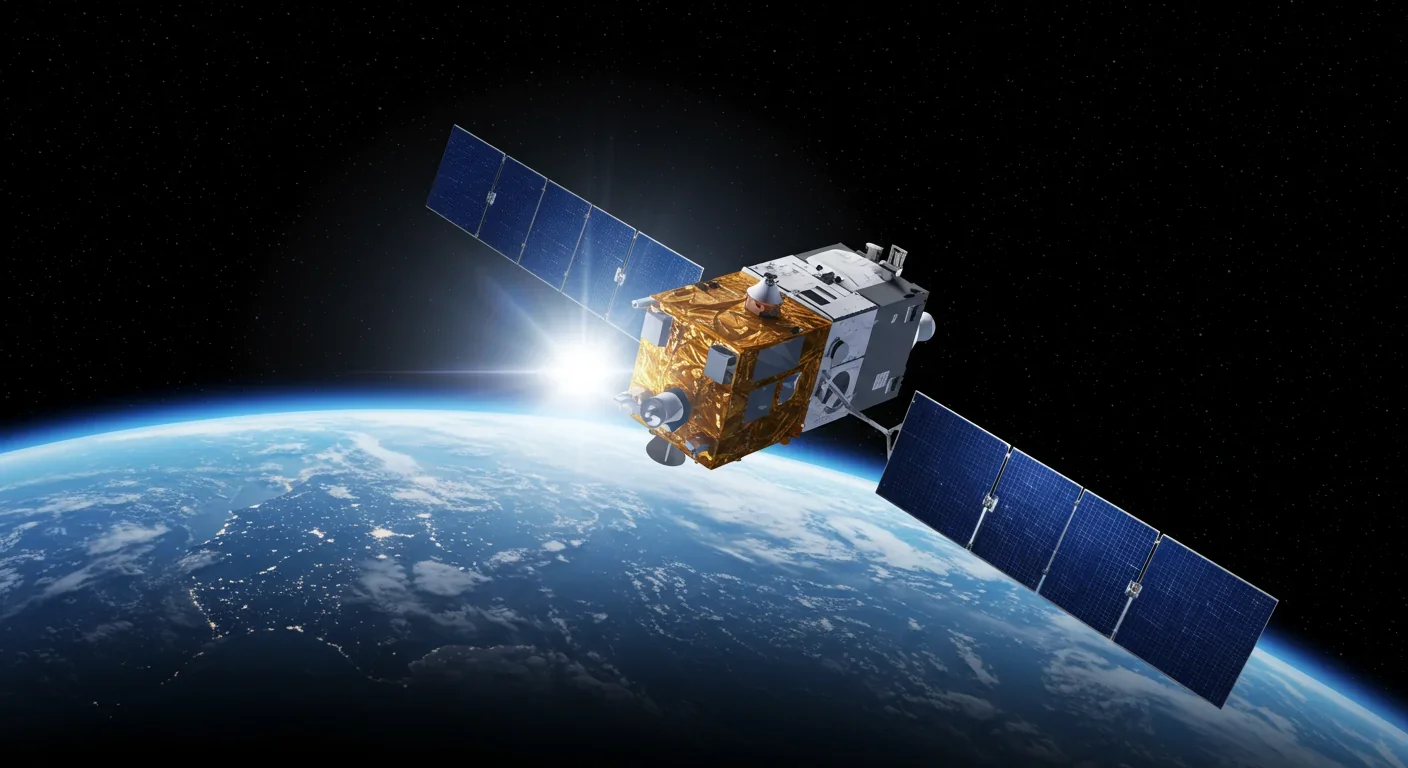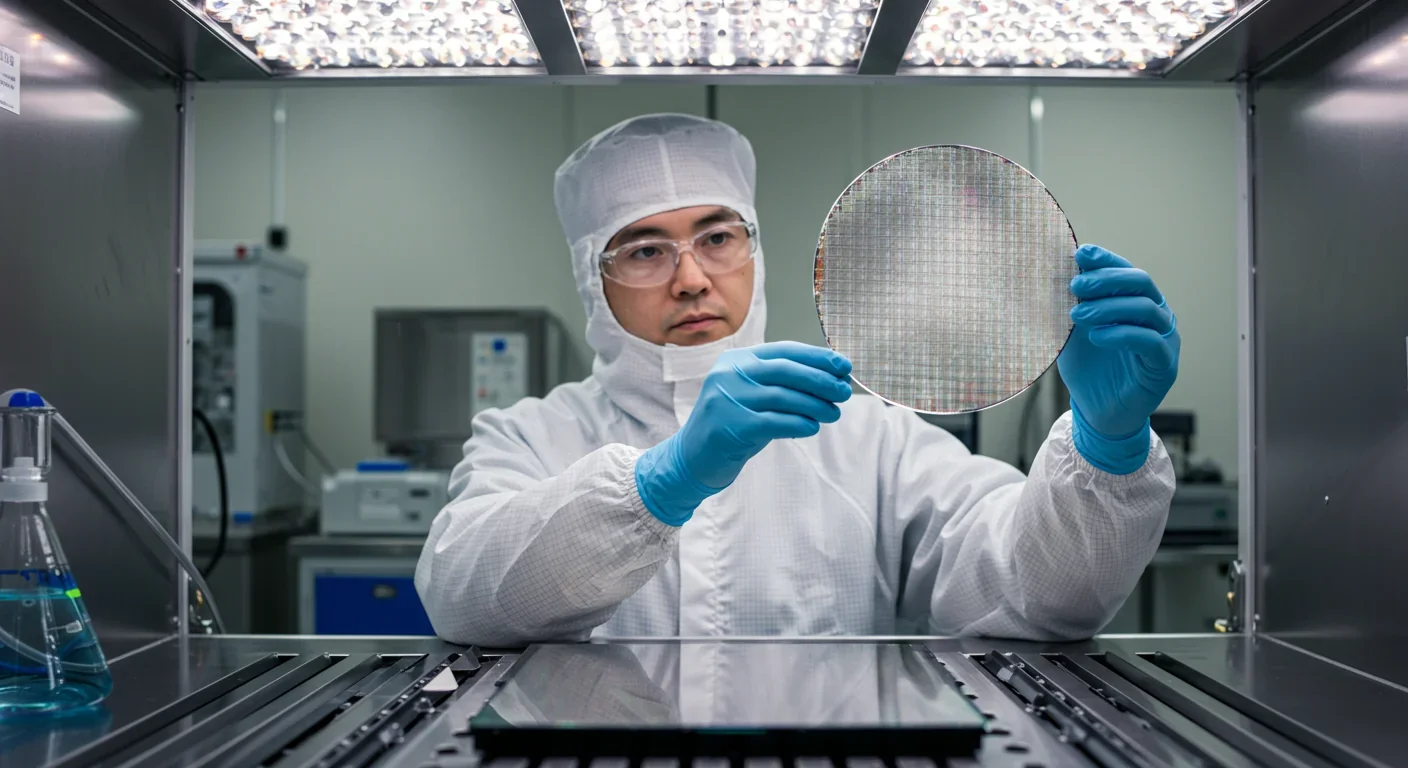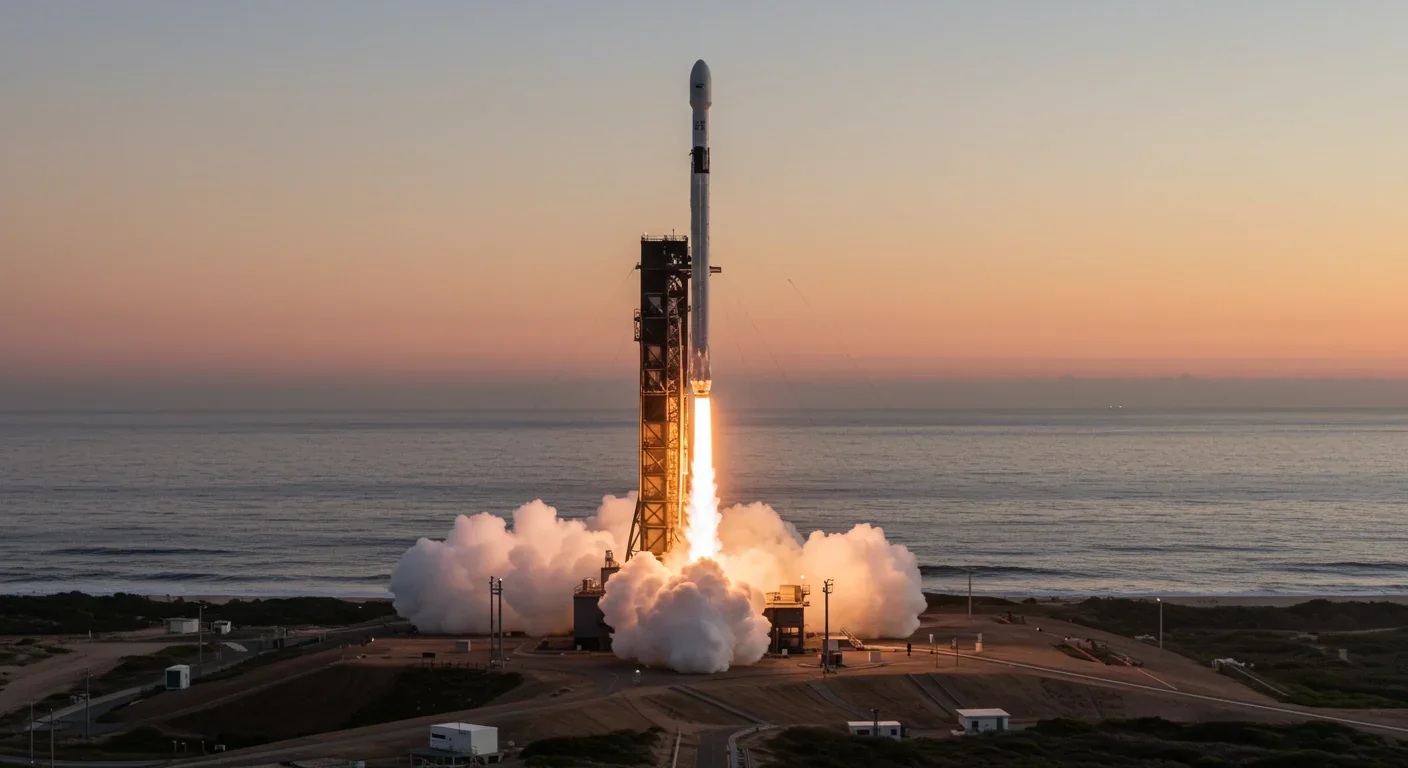Mars Methane Mystery: Hidden Microbes or Geology?

TL;DR: By 2027, orbital semiconductor factories could deliver crystals with 1000x fewer defects than Earth-made chips. Companies like Space Forge and United Semiconductors are racing to prove commercial viability, backed by $30M in funding and $13.7B in Space Force launch contracts.

By 2027, the first commercial batches of microchips grown in orbit could land on Earth, bringing with them crystals three times larger and up to 1000 times fewer defects than anything manufactured under gravity's relentless pull. This isn't science fiction pitched by space dreamers. It's a timeline backed by satellite launches already underway, partnerships between semiconductor giants and aerospace companies, and over $30 million in fresh venture capital flowing to startups racing to build factories where physics works differently.
The stakes couldn't be higher. Every smartphone, electric vehicle, and data center depends on semiconductor chips that have hit a manufacturing ceiling. Traditional methods struggle to produce the defect-free crystals needed for next-generation electronics. Meanwhile, microgravity offers something Earth can't: an environment where molten silicon settles into near-perfect atomic arrangements, free from convection currents and gravitational stress that create microscopic flaws.
When Dr. Jessica Frick of Astral Materials presented at NIST, she outlined exactly why orbital manufacturing represents more than incremental improvement. In microgravity, the forces that plague terrestrial crystal growth (buoyancy, sedimentation, container interactions, hydrostatic pressure, thermal convection) simply vanish.
The numbers tell the story. Research conducted on the International Space Station has demonstrated crystals growing not just larger but with dramatically improved uniformity. The persistent microgravity environment allows atoms and molecules to incorporate into the crystalline lattice slowly and orderly, layer by layer, without gravity-driven disruptions.
This matters because modern semiconductors demand materials beyond silicon. Gallium arsenide, indium phosphide, and other compound semiconductors power everything from 5G networks to quantum computers, but terrestrial methods yield small volumes of poor-quality crystals. The CHIPS and Science Act of 2022 acknowledged that the United States lags decades behind in manufacturing capacity. Orbital production could leapfrog that gap entirely.
Space Forge, a UK-based startup, raised £22.6 million in Series A funding (the largest for any British space tech company) precisely because investors recognized this fundamental advantage. "Microgravity gives us perfect crystals every time," their materials scientists explained, describing results impossible to replicate in any terrestrial lab.
The race to orbit involves both aerospace giants and specialized startups, each approaching the challenge differently. Space Forge launched their ForgeStar-1 satellite in June aboard a SpaceX Falcon 9 as part of the Transporter-14 rideshare mission. Their approach? A returnable satellite platform that manufactures materials in orbit, then uses an umbrella-like reentry system (nicknamed "Mary Poppins from space") to bring finished crystals safely back to Earth.
The partnership landscape reveals serious commercial intent. Space Forge signed a memorandum of understanding with United Semiconductors, a major Taiwanese manufacturer, to develop advanced materials deposition processes tailored for microgravity. United Semiconductors will handle crystal growth and wafer processing expertise, while Space Forge provides the orbital platform and logistics. Their explicit goal: demonstrate commercial viability at scale and develop frameworks with long-term customers.
Meanwhile, Sierra Space is constructing end-to-end infrastructure (the Dream Chaser spaceplane combined with inflatable station modules) specifically designed as a manufacturing hub for microgravity production. This isn't a research experiment. It's industrial infrastructure planned for sustained operations.
The launch capacity is real and expanding. The U.S. Space Force awarded $13.7 billion in contracts to SpaceX, United Launch Alliance, and Blue Origin for 54 national-security missions flying between 2027 and 2032. SpaceX alone secured 28 missions for $5.9 billion. Blue Origin's New Glenn rocket reached orbit in January 2025, with a payload fairing twice the volume of any commercial launch system (ample space for manufacturing equipment).
DARPA's in-space manufacturing program has selected teams for orbital demonstrations, including the California Institute of Technology's autonomous robotic construction system launching aboard SpaceX's Transporter-16 mission. When the Department of Defense backs orbital manufacturing demonstrations, the technology crosses from speculative to strategic.
The 2027 timeline emerges from converging factors, not wishful thinking. Launch infrastructure is operational today. SpaceX's Falcon 9 and Falcon Heavy rockets are certified for national-security payloads, meaning they meet the stringent reliability standards needed for expensive orbital facilities. ULA's new Vulcan Centaur just received certification. Blue Origin's New Glenn is flying.
Current ISS semiconductor experiments involve Axiom Space, Redwire, and United Semiconductors collaborating on NASA's InSPA microgravity crystal growth project. But here's the catch: the ISS environment remains incompatible with full-scale semiconductor production due to contamination from human life support systems. That's why dedicated, uncrewed manufacturing platforms are essential.
Space Forge's 2025 satellite launch provided proof-of-concept for their returnable platform. Their next phase involves scaling production capacity and refining reentry systems. The materials deposition processes developed with United Semiconductors during 2025-2026 should be ready for commercial demonstration by 2027.
Financial momentum reinforces technical readiness. Space Forge's $30 million Series A valued the company over $200 million (serious money for a startup yet to deliver commercial products). That valuation reflects investor confidence in both the technology and the market demand.

Here's where optimism meets hard reality. Launch costs remain the primary barrier. While SpaceX has driven prices down dramatically (Falcon 9 launches run about $67 million, roughly $2,500 per kilogram to low Earth orbit) that's still expensive for mass production.
A single semiconductor fabrication plant on Earth costs $10-20 billion. Orbital facilities won't replace these. Instead, the economic case depends on producing specialized, high-value materials that justify the launch premium. Compound semiconductors for quantum computing, ultra-pure crystals for advanced sensors, materials for next-generation photonics (these are the initial target markets).
Manufacturing in space faces unique cost structures. You're not just paying for launch. You need redundant systems, remote operations, radiation hardening, thermal management without atmosphere, and retrieval mechanisms. Every kilogram matters because every kilogram costs money to lift and return.
The counterargument? If orbital production yields crystals with 1000 times fewer defects, you might need only a fraction of the material to produce the same number of working chips. Semiconductor manufacturing already discards substantial material due to defects. Perfect crystals change that equation.
Moreover, as launch costs continue declining (SpaceX's Starship aims for under $100 per kilogram) the economics shift dramatically. At that price point, orbital manufacturing could compete with terrestrial methods for a broader range of products.
Semiconductors sit at the center of every major geopolitical tension. The CHIPS Act funneled $52 billion into domestic manufacturing because chip supply chains determine military capabilities, economic competitiveness, and technological leadership. China invests hundreds of billions in semiconductor independence. Taiwan's dominance in advanced chip production makes it a flashpoint.
Orbital manufacturing introduces a new dimension. Space has been called "the ultimate high ground" by U.S. Space Force officials for good reason. Manufacturing capabilities in orbit exist beyond any single nation's territorial control, yet access depends on launch capabilities concentrated in American companies.
Consider the strategic implications. If advanced semiconductor materials can only be produced economically in microgravity, whoever controls orbital infrastructure controls critical supply chains. The Outer Space Treaty prohibits national appropriation of celestial bodies, but commercial activities in Earth orbit occupy a legal gray zone that international space law hasn't fully addressed.
Nations investing in orbital manufacturing capabilities today (through both commercial partnerships and military programs) position themselves for technological leadership tomorrow. The Pentagon's $714 million in launch contracts to SpaceX and the Space Force's emphasis on "launch resiliency and capacity" reflect awareness that space infrastructure has become strategic infrastructure.
Microgravity crystal growth works beautifully in laboratory settings. Scaling to industrial production involves challenges that research papers tend to gloss over. How do you maintain ultra-high vacuum conditions for months at a time? What happens when a critical component fails and you can't send a technician? How do you handle toxic precursor gases in an enclosed orbital facility?
Temperature control in space is counterintuitive. Without atmospheric convection, heat doesn't dissipate naturally. Semiconductor crystal growth requires precise thermal gradients, yet managing heat in vacuum demands elaborate radiator systems. One equipment malfunction could ruin an entire production batch representing millions in investment.
Then there's contamination. The whole point is growing pure crystals, but spacecraft outgassing, micrometeorite damage, and solar radiation all introduce contaminants. Cleanroom standards on Earth are tough enough. Maintaining equivalent purity in orbit, with limited ability to replace filters or perform maintenance, requires engineering solutions that haven't been proven at scale.
Quality control presents another puzzle. On Earth, you can inspect crystal growth in real-time, adjust parameters immediately, and test samples continuously. In orbit, most of these processes must be automated with minimal human oversight. Machine learning helps, but semiconductor manufacturing tolerances are measured in nanometers. That's a tough ask for autonomous systems.

Assuming orbital manufacturing overcomes these hurdles and reaches commercial scale by the late 2020s, what changes for everyday technology users? The first applications will be invisible (specialized components in infrastructure you'll never see). Better crystals for fiber optic networks mean faster internet. Superior materials for quantum computing accelerate development of technologies that seem like magic today.
Within five to ten years, if projections hold, orbital-manufactured materials could appear in consumer devices. Your smartphone's 6G modem might contain compound semiconductors grown in microgravity. The solid-state batteries in electric vehicles could use ultra-pure crystals impossible to manufacture on Earth. Medical imaging equipment might employ sensors with unprecedented sensitivity.
The broader impact extends beyond specific products. If space-based manufacturing proves viable for semiconductors, it validates the concept for other materials (fiber optics, pharmaceuticals, advanced alloys). The ISS has already demonstrated success with protein crystal growth for drug development. Semiconductors could be the breakthrough that makes orbital manufacturing routine rather than experimental.
Policy makers face questions with no precedent. Who regulates manufacturing facilities in international waters (or rather, international space)? The Outer Space Treaty of 1967 was written for a different era. FAA and FCC regulations cover launches and communications, but commercial manufacturing in orbit occupies gaps in existing frameworks.
Intellectual property becomes interesting. If a patented process performs differently in microgravity, does the original patent cover it? If trade secret formulas depend on gravity-driven mixing, can competitors exploit the same chemistry in space without infringement? International patent law meets orbital mechanics in uncharted territory.
Investment patterns are shifting already. The fact that Space Forge raised record funding for a UK space tech company signals that venture capital sees commercial viability approaching. Traditional semiconductor manufacturers like United Semiconductors partnering with space startups indicates the industry takes this seriously, not as distant future speculation but as near-term strategic positioning.
Universities are adapting too. Materials science programs now include microgravity physics. Aerospace engineering departments add semiconductor manufacturing to curricula. The workforce for orbital factories is being trained today, which means industry expects to need those workers within a typical university timeframe (three to five years).
If the current trajectory holds, late 2027 could see the first commercial-scale semiconductor crystals returning from orbit. Not in massive volumes that reshape global supply chains overnight, but in quantities sufficient to prove commercial viability and establish baseline economics. The materials will be analyzed, compared against terrestrial equivalents, and priced for market entry.
Success in that first commercial demonstration triggers a cascade. More investment flows in. Launch providers expand capacity. Semiconductor manufacturers commit to long-term contracts. Within a decade, orbital manufacturing could transition from novelty to established industry segment, much like satellite communications evolved from experimental to essential infrastructure.
Failure is equally possible. Technical challenges might prove more expensive to solve than anticipated. Quality control problems could make defect rates acceptable but not dramatically better than improved terrestrial methods. Economics might never close the gap between launch costs and product premiums. Space is littered (sometimes literally) with ventures that sounded inevitable until they weren't.
The difference this time is the convergence of mature technologies. Launch costs have dropped two orders of magnitude. Autonomous systems can handle operations humans can't personally oversee. Materials science understands exactly why microgravity improves crystal growth. The semiconductor industry desperately needs innovation to continue performance improvements. Every piece is in place except the final proof that combining them works at commercial scale.
That proof arrives in 2027, one way or another. The satellites are launching. The partnerships are signed. The investment is committed. We'll either witness the birth of orbital industry or learn expensive lessons about the limits of space commerce. But either way, we're about to find out whether manufacturing's future points upward.

Curiosity rover detects mysterious methane spikes on Mars that vanish within hours, defying atmospheric models. Scientists debate whether the source is hidden microbial life or geological processes, while new research reveals UV-activated dust rapidly destroys the gas.

CMA is a selective cellular cleanup system that targets damaged proteins for degradation. As we age, CMA declines—leading to toxic protein accumulation and neurodegeneration. Scientists are developing therapies to restore CMA function and potentially prevent brain diseases.

Intercropping boosts farm yields by 20-50% by growing multiple crops together, using complementary resource use, nitrogen fixation, and pest suppression to build resilience against climate shocks while reducing costs.

Cryptomnesia—unconsciously reproducing ideas you've encountered before while believing them to be original—affects everyone from songwriters to academics. This article explores the neuroscience behind why our brains fail to flag recycled ideas and provides evidence-based strategies to protect your creative integrity.

Cuttlefish pass the marshmallow test by waiting up to 130 seconds for preferred food, demonstrating time perception and self-control with a radically different brain structure. This challenges assumptions about intelligence requiring vertebrate-type brains and suggests consciousness may be more widespread than previously thought.

Epistemic closure has fractured shared reality: algorithmic echo chambers and motivated reasoning trap us in separate information ecosystems where we can't agree on basic facts. This threatens democracy, public health coordination, and collective action on civilizational challenges. Solutions require platform accountability, media literacy, identity-bridging interventions, and cultural commitment to truth over tribalism.

Transformer architectures with self-attention mechanisms have completely replaced static word vectors like Word2Vec in NLP by generating contextual embeddings that adapt to word meaning based on surrounding context, enabling dramatic performance improvements across all language understanding tasks.